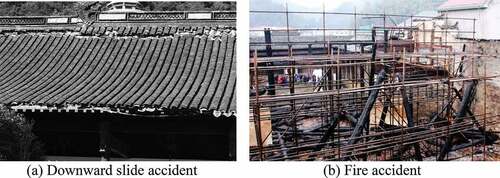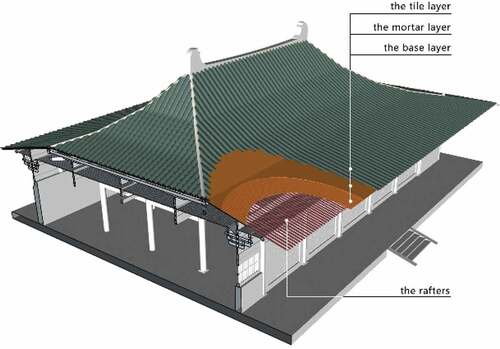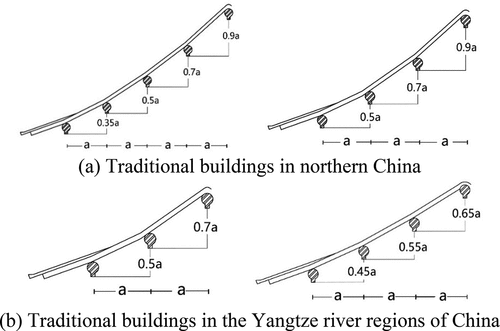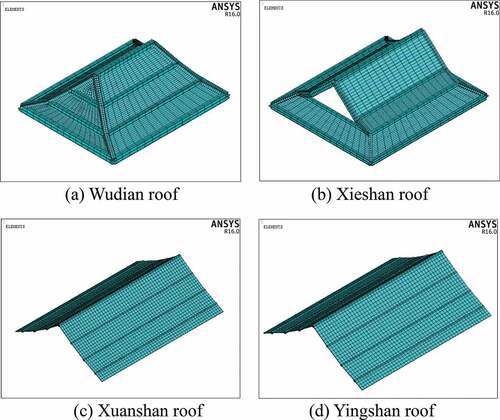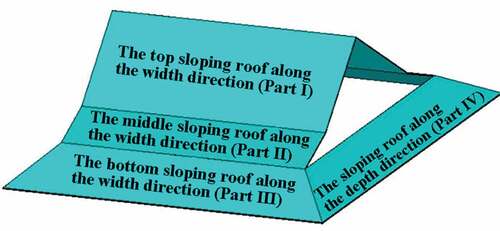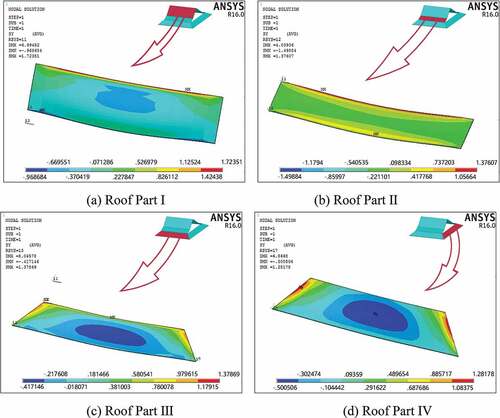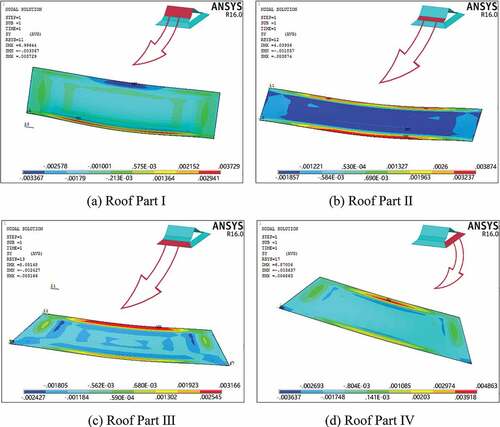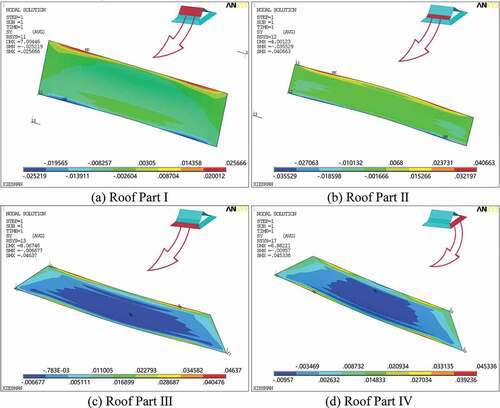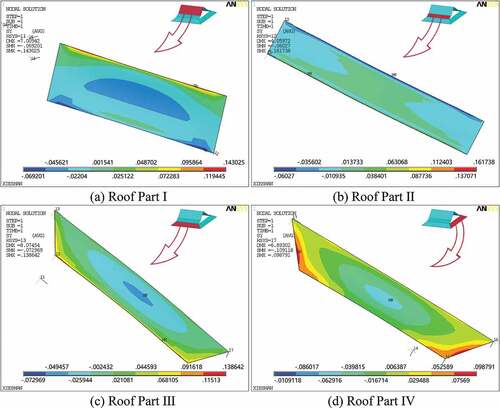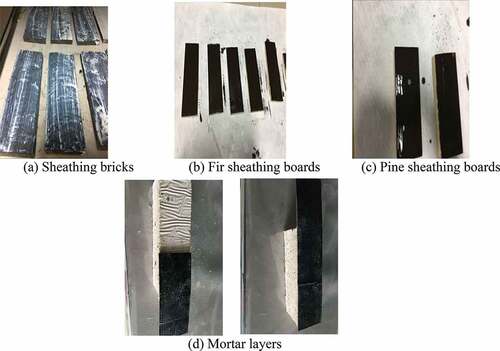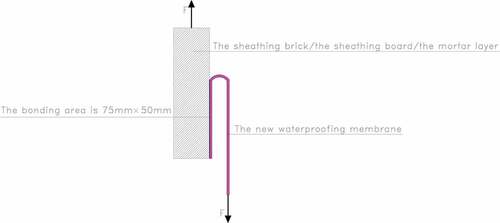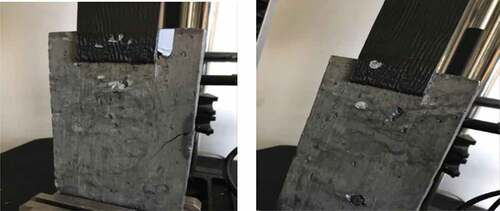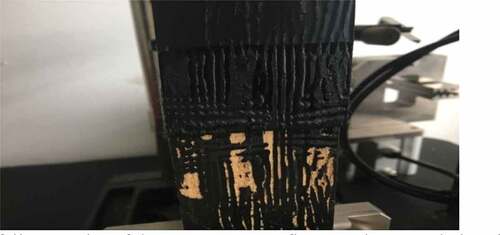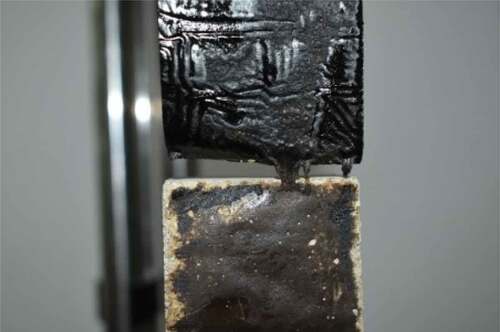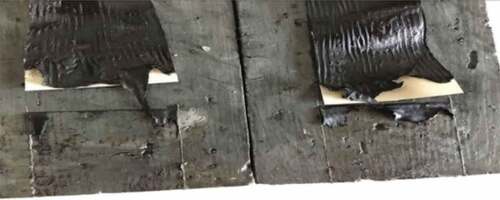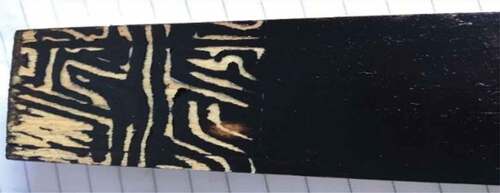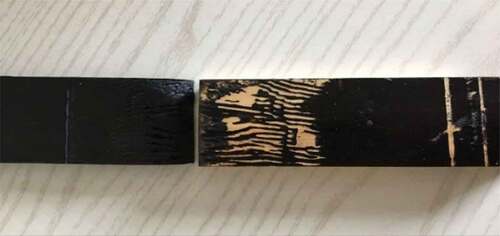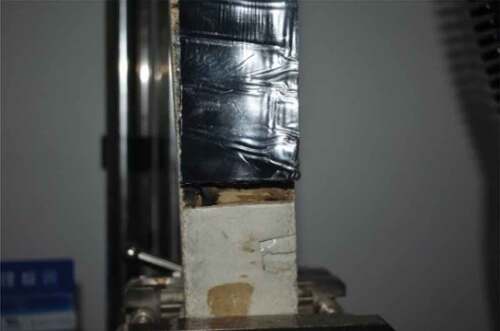ABSTRACT
The roof configurations of traditional Chinese timber buildings are unique and noticeably different from those of modern buildings, and their roof waterproofing performance is typically very poor. To improve their waterproofing performance, a new adaptive waterproofing membrane was developed and examined. First, typical roof configurations of traditional Chinese timber buildings were investigated and categorized. Then, finite element models of four typical roofs were established in ANSYS, and the stress distributions at the interfaces between the waterproofing membrane layer and adjacent roof layers were studied. Finally, a new adaptive roof waterproofing membrane for traditional Chinese timber buildings was developed, and relevant experiments on its material properties and mechanical performance were carried out. The properties of the new membrane were compared with those of ethylene propylene diene monomer, styrene-butadiene-styrene and atactic polypropylene waterproofing membranes. The results showed that the new waterproofing membrane has very good material properties and can meet the structural safety requirements for the roofs of traditional Chinese timber buildings. This membrane may also provide an adaptive conservation solution for such buildings and can substantially improve the waterproofing performance and durability.
Graphical Abstract

1. Introduction
China has a large number of traditional buildings, including 37 World Cultural Heritages and nearly 770,000 historical buildings (Liu Citation2018; Chun and Xu Citation2020). These buildings are historical evidence and valuable reminders of China’s civilization. A majority of Chinese historical buildings are traditional timber buildings. Among the 2,162 ancient buildings protected at the national level, 1,532 are traditional timber buildings, accounting for more than 70% (Chun and Xu Citation2020). Traditional Chinese timber buildings are mainly composed of roof parts, body parts and pedestal parts and are therefore called “three-part buildings”. The roof part is the largest area, and it is the most distinctive and prominent part of traditional Chinese timber buildings.
The roof waterproofing principle of ancient Chinese buildings is that “ drainage is the most important, and waterproofing is secondary” (Zhang Citation2016). Therefore, most ancient buildings have no additional flexible waterproofing layer as parts of their roofs, with the exception of the special metal flexible waterproofing layer used in the roofs of a few royal buildings in the Forbidden City (Jia Citation2009). However, to date, the material performance and structural behaviour of roofs in traditional Chinese timber buildings have deteriorated to varying degrees, with many of them experiencing leaking. Therefore, the first choice for solving the waterproofing problem is to use a flexible waterproofing membrane, which can meet the requirements of the minimum interference and reversibility principles (MOHURD Citation2012a; AQSIQ Citation2011a; CNWBMIA Citation2008; MOHURD Citation2013; AQSIQ Citation2011b). However, there has been a lack of research and development into a suitable flexible waterproofing membrane for application to the roofs of traditional Chinese timber buildings. As a result, many detrimental incidents have occurred in recent years in China due to improper applications of waterproofing membrane technology, as shown in . The accident illustrated in ) occurred due to the downward slide of the roof tiles, which was mainly caused by the poor bonding strength of the styrene-butadiene-styrene (SBS) waterproofing membrane. The accident shown in ) occurred due to a fire on the roof, which was mainly caused by the improper application of the hot-melt method during SBS waterproofing membrane construction.
At present, much research has been conducted on roof waterproofing techniques. Bailey et al. (Bailey and Bradford Citation2005) reported that the performance of a roof can be substantially improved by strengthening quality assurance processes during installation, particularly by ensuring that installers comply with contract specifications and utilize industry-accepted construction practices. Walter et al. (Walter, de, and Lopes Citation2005) proposed a classification system for the inspection of roof waterproofing layers and listed and classified the main problems in roof waterproofing layers. Marques et al. (Marques, Lopes, and Correia Citation2010) presented an experimental study on the behaviour of self-protection granules of bituminous membranes when subjected to environmental agents of degradation. Carretero-Ayuso et al. (Carretero-Ayuso and de Citation2016) verified the execution processes of waterproofing membranes to reduce the number of failures. Hu et al. (Hu, Jian, and Liu et al. Citation2016) studied the influence of joint treatment methods and the SBS content on the peel strength of SBS-modified asphalt waterproofing membranes. Feng et al. (Feng, Li, and Cui. Citation2016) compared the compositions and applications of a SBS-modified asphalt waterproofing membrane and a polyethylene polypropylene composite waterproofing membrane. Zhang et al. (Zhang and Tao Citation2016) studied the material performance of North American rock asphalt and SBS-modified asphalt. Yang (Yang Citation2016) studied the effect of bonding temperature on the peel strength of SBS- and atactic polypropylene (APP)-modified asphalt waterproofing membranes during the hot-melt construction process. Ming (Ming Citation2017) discussed the relationship between the molecular structure of polyolefin elastomers and some important properties of polymer waterproofing membranes, such as flexibility, processability, weldability, fireproof capability and weatherability. Garrido et al. (Garrido, Antonio, and Lopes et al. Citation2018) conducted an experimental study on the joint performance of an aged asphalt roll and a new asphalt roll to evaluate the repair effect of the waterproofing system.
Currently, there are several types of waterproofing membranes, including the abovementioned SBS and APP waterproofing membranes, as well as ethylene propylene diene monomer (EPDM) waterproofing membranes. However, these types of membranes are only applicable to modern buildings and not to traditional buildings, which are significantly different. For instance, the main construction method for SBS and APP waterproofing membranes is the hot-melt method, which necessitates fire work at construction sites. However, fire work is very dangerous for timber buildings. SBS, APP and EPDM waterproofing membranes are commonly used on modern buildings with concrete roofs, and the loads on these roofs are relatively light. Traditional timber buildings have very different roof configurations from those of modern buildings. Traditional timber buildings have relatively high loads of tiles and mortars as well as steep roof slopes. Dedicated studies and tests on the applications of SBS, APP and EPDM for traditional Chinese timber buildings are lacking. Thus, the use of SBS, APP and EPDM as roof waterproofing membranes poses potential safety hazards for traditional Chinese timber buildings.
In this study, investigations on traditional Chinese timber buildings are presented first, providing special requirements for roof waterproofing membranes. Then, a new adaptive roof waterproofing membrane for traditional Chinese timber buildings is developed and tested. The main objective of this study is to develop a new adaptive material to improve the water resistance of roofs of traditional Chinese timber buildings.
2. Research methods
The methodology of this study is a combination of theoretical analysis and experimental study. According to the literature review, no relevant research on the water resistance of the roofs of traditional Chinese timber buildings or on the waterproofing membranes for traditional Chinese timber building roofs has been reported. Thus, since a new waterproofing membrane for traditional Chinese timber buildings has been taken as research objective in this study, it was necessary to first conduct some primary research on the characteristics of the roof configurations and the stress distributions of different parts of the roofs of traditional Chinese timber buildings. Based on literature research and case studies, the characteristics of four typical roofs of traditional Chinese timber buildings were studied. Then, finite element models of the four typical roof types were designed and constructed based on the investigation of the actual roof configurations of traditional Chinese timber buildings. The stress distributions at the interfaces between the waterproofing membrane layer and adjacent roof layers were analysed by the finite element method (FEM). According to FEM analysis, a development strategy for a new adaptive waterproofing membrane for traditional Chinese timber buildings was proposed. Finally, to determine whether this new waterproofing membrane could meet the proposed strategy, some relevant experiments on its material properties and mechanical performance were carried out. The experimental results were also compared with the corresponding properties of some other commonly used waterproofing membranes.
3. Theoretical study of the typical roofs of traditional Chinese timber buildings
3.1. Typical roof configurations of traditional Chinese timber buildings
The roof types of traditional Chinese timber buildings mainly include the Wudian type, Xieshan type, Xuanshan type, and Yingshan type. The characteristics of the four typical roof types are shown in .
Table 1. Main characteristics of the four typical roofs.
As shown in , the roof configuration of traditional Chinese timber buildings can be divided into three layers from bottom to top: the base layer (the brick layer or the board layer), the mortar layer, and the tile layer (the small tile layer or the semi-circular tile layer). Because traditional buildings in northern China are located in cold regions, their roof mortar layers are generally thick, ranging in thickness from 5 to 10 cm. Because traditional buildings in the Yangtze River region of China are located in regions with cold winters and scorching summers, their roof mortar layers are generally thin; their thickness is approximately 2 to 4 cm. Traditional buildings in southern China have basically no roof mortar layers because they are located in regions with warm winters and scorching summers.
According to actual surveys of dozens of traditional buildings in northern China, the Yangtze River region of China, and southern China, the weight of a semi-circular tile roof is approximately 3.0 to 3.8 kN/m2 (including the mortar layer and the tile layer), and the weight of the small tile roof is approximately 1.5 to 2.4 kN/m2 (including the mortar layer and the tile layer) (MOHURD Citation2012b). In northern China, the roof slopes from eaves to ridges commonly range from 19° to 42° (Liang Citation2006). In the Yangtze River regions of China, the roof slopes from eaves to ridges are mainly between 24° and 35° (Yao, Zhang, and Liu Citation1959), while in southern China, they are often between 19° and 27° (Ping Citation2018) (as shown in ).
According to the above studies, the roof characteristics of traditional Chinese timber buildings are summarized in .
Table 2. Roof characteristics of traditional Chinese timber buildings.
3.2. Numerical analysis of roof stresses in traditional Chinese timber buildings
To improve the waterproofing performance of roofs of traditional Chinese timber buildings, a roof waterproofing membrane can be added between the base and mortar layers. To develop a suitable roof waterproofing membrane, the theoretical stresses between different layers need to be studied first. According to the survey results of the roof configurations of traditional Chinese timber buildings, typical Wudian, Xieshan, Xuanshan and Yingshan roofs were chosen for analysis of their mechanical properties. The finite element models of these four roofs were created in ANSYS 16.0, as shown in . Their geometrical information was obtained from an investigation of real traditional Chinese timber buildings. The analysis was simplified by modelling only the purlins and roofs. Each roof layer was simulated by using SOLID185 elements, and the purlins were simulated with BEAM189 elements. In the finite element models in this study, there were five layers for each part of the roof (), namely, one sheathing board (brick) layer (20 mm), one bottom glue layer (0.5 mm), one waterproofing membrane layer (1.5 mm), one top glue layer (0.5 mm), and one mortar layer (20 mm). The nodes in the coincidence position were coupled at the interfaces between the layers. In this study, the condition with a sheathing brick layer and the condition with a sheathing board layer were considered for each type of roof. In the finite element models, the elastic modulus of the sheathing board was taken as 9,000 MPa, and that of the sheathing brick was taken as 10,000 MPa (MOHURD Citation2011, CSWADI Citation2017). The elastic modulus of the mortar was taken as 500 MPa (MOHURD Citation2011, CSWADI Citation2017). According to the investigation of common waterproofing membranes, the elastic modulus of the glue layer ranges from 0.8 to 1.5 MPa, and that of the waterproofing membrane ranges from 100 to 160 MPa (Gao Citation2009; Yang et al. Citation2011). Thus, two combinations of the elastic modulus of the glue layer and the waterproofing membrane were considered: (1) 0.8 MPa for the glue layer and 100 MPa for the waterproofing membrane; and (2) 1.5 MPa for the glue layer and 160 MPa for the waterproofing membrane. The densities of the sheathing board, sheathing brick, waterproofing membrane, and mortar were taken as 0.5 × 103 kg/m3, 2.3 × 103 kg/m3, 1.4 × 103 kg/m3, and 2.0 × 103 kg/m3, respectively (MOHURD Citation2012b).
Two types of roof tile construction (small tile and semi-circular tile) were used in this study, resulting in different dead loads applied on the roof: the dead load of the small tile roof was taken to be 2.4 kN/m2, whereas the dead load of the semi-circular tile roof was taken to be 3.8 kN/m2. Both the small tile roof and semi-circular tile roof had live loads of 0.7 kN/m2. For the boundary condition, the purlins were only fixed at the connection joints of purlins and columns, leaving all other nodes free and unconstrained.
Due to the different loads, base layers, glue layers and waterproofing membrane layers, eight calculation conditions based on the combinations of the load, base layer, glue layer and waterproofing layer were analysed for each type of roof in this study, and the details are listed in . In the table, “√” represents the parameters that were adopted for the calculation conditions, while “×” represents the parameters that were not adopted for the calculation conditions.
Table 3. Calculation conditions of the four roofs considering the waterproofing membrane.
In this paper, the Xieshan roof with the base layer of the sheathing board was taken as an example. Given its symmetry, four roof parts were selected for detailed analysis: the top sloping roof along the width direction (Part I), the middle sloping roof along the width direction (Part II), the bottom sloping roof along the width direction (Part III), and the sloping roof along the depth direction (Part IV), as shown in .
3.3. Results and discussion
For each of the four roof parts in , the tangential stress and normal stress distributions in the four interfaces were studied. These interfaces include those between the sheathing board layer and the bottom glue layer (Interface 1), the bottom glue layer and the waterproofing membrane layer (Interface 2), the waterproofing membrane layer and the top glue layer (Interface 3), and the top glue layer and the mortar layer (Interface 4). The FEM analysis results for the Xieshan roof under Condition 1 are shown in and
Table 4. FEM results of the tangential stresses and the normal stresses.
As shown in , the distributions of tangential stresses at the different interfaces exhibit some similarities. Generally, for the interfaces of the four roof parts involved in this study, the tangential stresses at the four edges are clearly higher than those at the central area. For Roof Parts I and II, the largest tangential stress generally occurs on the long side, while the tangential stresses on the two short sides are relatively small. For Roof Parts III and IV, the largest tangential stress also generally occurs on the long side, while the tangential stresses on the two short sides are also relatively large. This is because the shapes and slopes of Roof Parts III and IV differ from those of Roof Parts I and II. In addition, it can be seen from the stress nephogram that there is an obvious stress concentration phenomenon on each roof part, but with a very small stress concentration area. Therefore, the maximum value of the stress concentration area on each roof part has no notable reference value. In this study, the average tangential stresses and the average normal stresses at the interfaces of each roof part were calculated, as shown in .
According to the results in , the average tangential stress and the average normal stress of Roof Part I are the highest for Interfaces 1, 2, 3, and 4. This is because Roof Part I has the greatest slope degree. The average tangential stresses at Interfaces 1, 2, 3 and 4 are 2720.3, 2717.3, 2744.1 and 2741.9 Pa, respectively. The average tangential stresses of these interfaces were approximated. The average normal stresses at Interfaces 1, 2, 3 and 4 are 3251.6, 3258.2, 3320.4 and 3316.8 Pa, respectively. According to the calculation results of the roof stresses of the four typical roofs under the eight working conditions, the stress distribution modes of the Wudian and Xieshan roofs are generally similar. Their average tangential stresses range from 2.0 to 5.0 kPa, and their average normal stresses range from 1.0 to 3.0 kPa. The stress distribution modes of the Xuanshan and Yingshan roofs are also similar. Their average tangential stresses range from 1.0 to 2.0 kPa, and their average normal stresses range from 0.8 to 1.4 kPa. In addition, the calculation results of the FEM models show that some stress concentrations occur at small areas of the different interfaces, such as the positions where the roof slopes change and where there are roof ridges. It is suggested that additional waterproofing membranes should be added at these positions to reduce the stress concentrations, as shown in .
4. Experimental study on a new adaptive waterproofing membrane for traditional Chinese timber buildings
4.1. Development strategy for a new waterproofing membrane
Based on the study results of the roof configurations and theoretical stresses for traditional Chinese timber buildings, the development strategy for a new adaptive waterproofing membrane for traditional Chinese timber buildings is as follows:
(1) The bond strength between the waterproofing membrane and the upper and lower layers should be strong enough to ensure the roof’s structural integrity.
(2) The construction method for the waterproofing membrane is the self-adhesive method rather than the hot-melt method. There is no need for fire in the construction process.
(3) The waterproofing membrane should have superior water tightness.
(4) The waterproofing membrane should have a certain adhesive thickness and excellent tear resistance to withstand damage from hard spikes during construction.
(5) The overall thickness of the waterproofing membrane should be small so that traditional Chinese timber buildings retain their appearance.
(6) When heated, the waterproofing membrane should have a minor dimensional change.
Through nearly 100 times of continuous premixing and testing trials, an innovative waterproofing membrane was developed. In this membrane, naphthenic rubber extender oil was added to the asphalt to improve the compatibility of the asphalt and rubber. A self-adhesive resin was added to the glue layer. The resin interacts with the plastic modifier to synergistically increase the compatibility, resulting in significantly improved peeling and shear strengths between the waterproofing membrane layer and the upper and lower layers, which meets structural safety requirements. Furthermore, the temperature resistance of the glue layer is increased, providing the new waterproofing membrane with good low temperature and heat resistances. The new membrane mixing ratio of the glue layer by weight is as follows: 40–50 units of asphalt, 30–40 units of talc, 8–14 units of naphthenic rubber extender oil, 3–7 units of styrene-butadiene-styrene block copolymer, 2–6 units of styrene-isoprene-styrene block copolymer, 3–6 units of self-adhesive resin, 1–3 units of plastic modifier, and 0.05–1 units of stabilizer.
The new waterproofing membrane is a layered structure with symmetrical distribution. As shown in , from the top to the bottom, it is composed of the top isolation membrane, top self-adhesive glue layer, strong stagger-laminated membrane layer, bottom self-adhesive glue layer, and bottom isolation membrane. The isolation membrane is an aluminium-plated isolation membrane that effectively reflects ultraviolet rays, protects the waterproofing membrane well, and significantly improves its durability.
4.2. Mechanical behaviour of the new waterproofing membrane
To verify whether the bond strength between the new waterproofing membrane and the upper and lower layers can meet the structural safety standards of traditional Chinese timber buildings, the bonding strengths between the membrane, sheathing board, sheathing brick and mortar layer were studied considering the actual roof configurations. In this study, test specimens were designed based on the study results of the actual roof configurations, and standard test methods were used to examine the peel and shear strengths of the membrane, adjacent sheathing board, sheathing brick, and mortar layer.
4.2.1. Test design
According to the study results of the roof configurations of traditional Chinese timber buildings, four types of test specimens were designed and tested in this study. This includes the test specimens of the new waterproofing membranes as well as (1) sheathing bricks, (2) fir sheathing boards, (3) pine sheathing boards, and (4) mortar layers. All tests were carried out at a constant temperature of 23 °C. These four types of specimens were cured for more than 24 h before the tests at a temperature of 23 °C and humidity of 80%. The four types of test specimens are shown in .
4.2.2. Peel test
First, the peel performance of the considered specimens was studied. The test method is shown in . The bonding area of every test specimen was 75 mm × 50 mm.
The peeling failure modes of the new waterproofing membranes and sheathing bricks are shown in , and the peel test results are shown in and .
Figure 16. Load-displacement curves from the peel tests of the new waterproofing membranes and sheathing bricks.
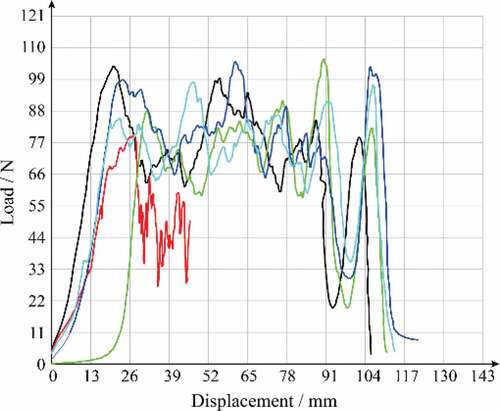
Table 5. Peel test results of the new waterproofing membranes and sheathing bricks.
The peeling failure modes of the new waterproofing membranes and fir sheathing boards are shown in , and the peel test results are shown in and .
Figure 18. Load-displacement curves from the peel tests on the new waterproofing membranes and fir sheathing boards.
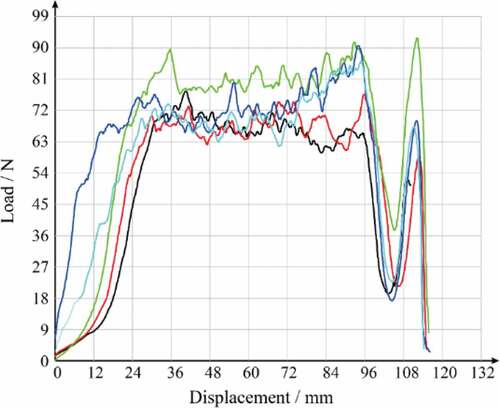
Table 6. Peel test results of the new waterproofing membranes and fir sheathing boards.
The peeling failure modes of the new waterproofing membranes and pine sheathing boards are shown in , and the peel test results are shown in and .
Figure 20. Load-displacement curves from the peel tests on the new waterproofing membranes and pine sheathing boards.
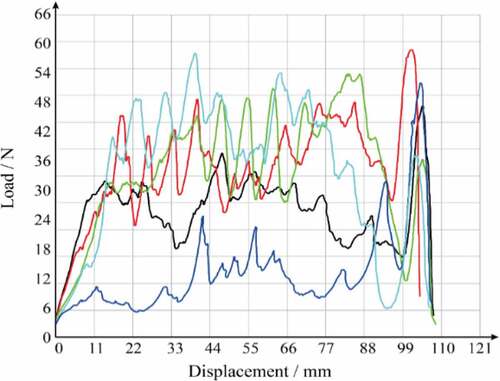
Table 7. Peel test results of the new waterproofing membranes and pine sheathing boards.
The peeling failure modes of the new waterproofing membranes and mortar layers are shown in , and the peel test results are shown in and .
Figure 22. Load-displacement curves from the peel tests on the new waterproofing membranes and the mortar layers.
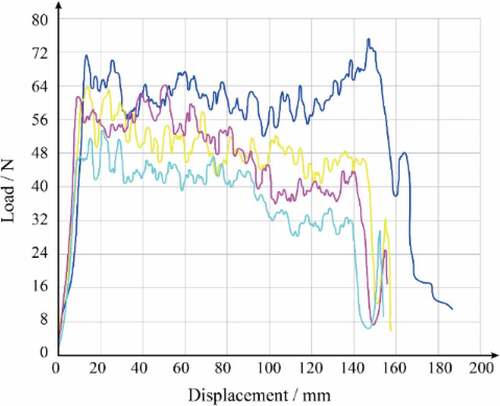
Table 8. Peel test results of the new waterproofing membranes and mortar layers.
4.2.3. Shear test
Second, the shear performance of the considered specimens was studied. The test method is shown in . The bonding area of every test specimen was 50 mm × 50 mm.
Figure 23. Shear test method The shear failure modes of the new waterproofing membranes and sheathing bricks are shown in.
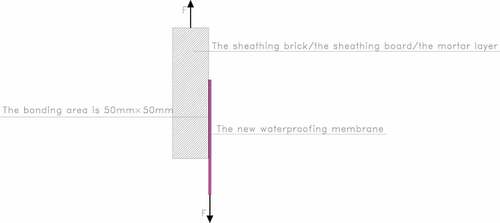
, and the shear test results are shown in and .
Figure 25. Load-displacement curves from the shear tests on the new waterproofing membranes and sheathing bricks.

Table 9. Shear test results of the new waterproofing membranes and sheathing bricks.
The shear failure modes of the new waterproofing membrane and fir sheathing board are shown in , and the shear test results are shown in and .
Figure 27. Load-displacement curves from the shear tests on the new waterproofing membranes and fir sheathing boards.
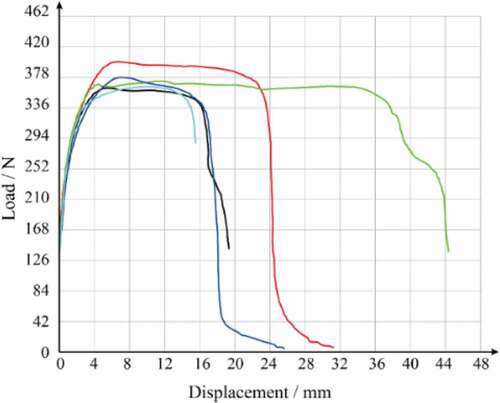
Table 10. Shear test results of the new waterproofing membranes and fir sheathing boards.
The shear failure modes of the new waterproofing membrane and pine sheathing board are shown in , and the shear test results are shown in and .
Figure 29. Load-displacement curves from the shear tests on the new waterproofing membranes and pine sheathing boards.

Table 11. Shear test results of the new waterproofing membranes and pine sheathing boards.
The shear failure modes of the new waterproofing membrane and mortar layer are shown in , and the shear test results are shown in and .
Figure 31. Load-displacement curves from the shear tests on the new waterproofing membranes and mortar layers.

Table 12. Shear test results of the new waterproofing membranes and mortar layers.
When the experimental results of the shear and peel tests performed on the considered specimens were compared with the theoretical results of the FEM simulations, it was found that the experimental values of the shear strength ranged from 131.18 to 227.72 kPa, which is substantially higher than the relevant theoretical tangential stress value. The experimental values of the peel strength ranged from 13.77 to 28.32 kPa, which is also substantially higher than the theoretical normal stress value. Thus, the experimental results show that the new waterproofing membrane can ensure the structural safety of traditional Chinese timber buildings.
4.3. Results and discussion
compares the physical and mechanical properties of this new waterproofing membrane with those of some other common waterproofing membranes to evaluate the advantages and disadvantages of the new waterproofing membrane.
Table 13. Comparison of physical and mechanical properties of different waterproofing membranes.
According to the comparative results of , this new waterproofing membrane has some clear advantages for traditional Chinese timber buildings.
In terms of construction methods, this new waterproofing membrane and EPDM waterproofing membranes do not require fire work during the construction process, clearly reducing fire risk when compared with SBS waterproofing membranes and APP waterproofing membranes, which require the hot-melt method. Moreover, EPDM waterproofing membranes have high requirements for construction technology, while the construction of this new waterproofing membrane is relatively simple. When the isolation film is uncovered during the construction process, it can be bonded to the base layer directly, resulting in much better adhesion with the upper and lower surfaces. Good adhesion provides a strong guarantee for the structural integrity of the roof.
This new waterproofing membrane adapts to structural deformation much better than other common traditional waterproofing membranes. Furthermore, the adhesive thickness of the new waterproofing membrane is higher than that of other waterproofing membranes, and its tear strength is greater than 400 N, 360 N greater than that of the EPDM waterproofing membrane and 100 N greater than that of the APP waterproofing membrane. It has a much stronger grip strength on roof fasteners such as nails and is much more difficult to tear. The excellent tear strength ensures that the waterproofing membranes can resist hard spike damage during the construction process.
This new waterproofing membrane is impervious to water for 120 minutes under 0.3 MPa pressure, while the EPDM waterproofing membrane is impervious to water for 30 minutes under 0.3 MPa. The SBS and APP waterproofing membranes are impervious to water for 30 minutes under 0.2 MPa. The results show that this new waterproofing membrane is extremely watertight. Furthermore, when heated, this new waterproofing membrane has a small dimensional change, which is similar to that of the SBS and APP waterproofing membranes but significantly smaller than that of the EPDM waterproofing membrane.
Considering that this new waterproofing membrane will primarily be used on the roofs of traditional Chinese timber buildings, it is very important to explore its peel strength and shear strength with the sheathing brick, sheathing board, and mortar layer. These strength data are the main drawbacks of EPDM, SBS, and APP waterproofing membranes. The high peeling and shear strength of this new waterproofing membrane with the sheathing brick, sheathing board and mortar layer can guarantee the structural integrity of traditional Chinese timber buildings.
It should be stated that this new waterproofing membrane did not outperform the other three waterproofing membranes in all tests, including heat resistance and low-temperature flexibility. Although the heat resistance and the low-temperature flexibility of this new waterproofing membrane were not the best, it still meets the environmental requirements in most areas of China. It should be used with caution in certain regions or conditions where the temperatures of the materials may be higher than 70 °C or lower than -25 °C, which can be viewed as a limitation of this new waterproofing membrane.
5. Conclusions and prospects
In this study, the configurations of four typical roofs of traditional Chinese timber buildings were studied, and the relevant roof construction layers, slopes, and loads were determined. Then, finite element models of these four typical roof types, namely, Wudian, Xieshan, Xuanshan and Yingshan, were established in ANSYS with respect to the traditional roof configurations. Based on the theoretical analysis of these four finite element models under eight working conditions, the tangential stress and normal stress status of the interfaces between the waterproofing membrane layers and the adjacent roof layers were obtained. Finally, based on the results of the actual roof configurations and the theoretical analysis, a new adaptive roof waterproofing membrane for traditional Chinese timber buildings was developed, and its physical and mechanical properties were experimentally studied and compared with those of other types of waterproofing membranes. The most important conclusions are as follows:
According to the theoretical study, the stress distribution modes of the Wudian and Xieshan roofs are similar, with average tangential stresses ranging from 2.0 to 5.0 kPa and average normal stresses ranging from 1.0 to 3.0 kPa. The stress distribution modes of the Xuanshan and Yingshan roofs are also similar, with average tangential stress and average normal stress ranging from 1.0 to 2.0 kPa and 0.8 to 1.4 kPa, respectively.
Stress concentrations easily occur at positions where the roof slopes change and where there are roof ridges. Thus, additional waterproofing membranes must be added at these positions to reduce the effects of stress concentration.
According to the experimental study, the shear strengths of the new waterproofing membranes and sheathing bricks, sheathing boards and mortar layers range from 131.18 to 227.72 kPa, which are substantially higher than the relevant theoretical tangential stresses. The corresponding peel strengths range from 13.77 to 28.32 kPa, which are also substantially higher than the theoretical normal stresses. The experimental results show that the new waterproofing membrane can meet the structural safety requirements for the roofs of traditional Chinese timber buildings.
The new waterproofing membrane has higher tear strength, lower oil penetration, stronger bonding strength, better water tightness, superior persistent adhesion, and better tensile performance than the other types of waterproofing membranes. It can be used on the sloping roofs of traditional Chinese timber buildings with the self-adhesive method, reducing the fire risk caused by hot-melt construction.
The new waterproofing membrane can also be used for the conservation of traditional buildings with roof configurations similar to traditional Chinese timber buildings, such as traditional Japanese timber buildings, traditional Korean timber buildings, and traditional Southeast Asian timber buildings.
The aims of this study were not only to develop a new waterproofing membrane for traditional Chinese timber buildings but also to increase awareness about roof water resistance of traditional timber buildings throughout Asia. This study is a preliminary research on the water resistance of traditional Chinese timber buildings, and it has some limitations. For example, this study lacks a comparative experimental study to verify the numerical results of the finite element models, and a durability study of this new waterproofing membrane should also be conducted. In the future, in addition to these four typical roof types, other traditional roof types will be studied further to widen the application scope of this new waterproofing membrane. Moreover, the thermal ageing performance and thermal stability, both of which are related to the durability of this new waterproofing membrane, should be studied.
Disclosure statement
No potential conflict of interest was reported by the author(s).
Data Availability Statement
All data, models, and code generated or used during the study appear in the submitted article.
Additional information
Funding
Notes on contributors
Qing Chun
Qing Chun male, born in 1979, is the Doctor in Structural Engineering and national certified structural engineer of China. He is currently a Professor of School of Architecture at Southeast University. His research areas are conservation techniques for historical buildings.
Hui Jin
Hui Jin male, born in 1993, is currently a Ph.D. student of School of Architecture at Southeast University. His research areas are conservation techniques for Chinese modern architectural heritages.
Yiwei Hua
Yiwei Hua male, born in 1995, has the Master's degree in Architecture from Southeast University. His research areas are conservation techniques for historical buildings.
Wenjie Zang
Wenjie Zang female, born in 1992, is currently a Ph.D. student of School of Architecture at Southeast University. Her research areas are material properties of Chinese architectural heritages.
Xutao Lin
Xutao Lin male, born in 1976, He is Vice President of Shengzhen JOABOA TECH Group. His research areas are developments of new waterproofing materials.
Jiheng Jiang
Jiheng Jiang male, born in 1979, He is Research & Development Director of Shengzhen JOABOA TECH Group. His research areas are developments of new waterproofing materials.
References
- AQSIQ (General Administration of Quality Supervision, Inspection and Quarantine of the People’s Republic of China). 2008. GB 18243-2008: Atactic Polypropylene (APP) Modified Bituminous Waterproof Sheet. Beijing, China: AQSIQ.
- AQSIQ (General Administration of Quality Supervision, Inspection and Quarantine of the People’s Republic of China). 2011a. GB 50693-2011: Technical Code for Slope Roof Engineering. Beijing, China: AQSIQ.
- AQSIQ (General Administration of Quality Supervision, Inspection and Quarantine of the People’s Republic of China). 2011b. GB 12952-2011: Polyvinyl Chloride Plastic Sheets for Waterproofing. Beijing, China: AQSIQ.
- Bailey, D. M., and D. Bradford. 2005. “Membrane and Flashing Defects in Low-slope Roofing: Causes and Effects on Performance.”Journal of Performance of Constructed Facilities19 (3): 234–243. doi:10.1061/(ASCE)0887-3828(2005)19:3(234).
- Carretero-Ayuso, M. J., and B. J. de. 2016. “Analysis of the Execution Deficiencies of Flat Roofs with Bituminous Membranes.” Journal of Performance of Constructed Facilities 30 (6): 1–8. doi:10.1061/(ASCE)CF.1943-5509.0000904.
- Chun, Q., and Q. F. Xu. 2020. FRP Strengthening Techniques of Timber Structures. Beijing, China: Science Press.
- CNWBMIA (China National Waterproof Building Materials Industry Association). 2008. GB 18242-2008: Styrene Butadiene Styrene (SBS) Modified Bituminous Sheet Materials. Beijing, China: CNWBMIA.
- CNWBMIA (China National Waterproof Building Materials Industry Association). 2009. GB 23441-2009: Self-adhering Polymer Modified Bituminous Waterproof Sheet. Beijing, China: CNWBMIA.
- CSWADI (China Southwest Architectural Design and Research Institute Co., Ltd). 2017. GB 50005-2017: Standard for Design of Timber Structures. Beijing, China: CSWADI.
- Feng, C., C.S. Li, and W. J. Cui. 2016. “The Comparison and Application of SBS Modified Bituminous Sheet Materials and Polyethylene Polypropylene Fiber Composite Waterproof Coiled Materials.” China Building Materials Science & Technology 25 (5): 163–164.
- Gao, Y. H. 2009. “Effects of Environmental Temperature on Deformation of High Molecular Waterproofing Membrane.” New Building Materials 8: 80–83.
- Garrido, M., D. Antonio, J. G. Lopes, et al. 2018. “Performance of Different Joining Techniques Used in the Repair of Bituminous Waterproofing Membranes.”Construction and Building Materials 158 :346–358. doi:10.1016/j.conbuildmat.2017.09.180.
- Hu, Q. C., L. Jian, X.B. Liu, J. W. Li, and J. C. Li. 2016. “Study on Influencing Factors of Seam Peel Strength of SBS Modified Asphalt Waterproofing Membrane.” China Building Waterproofing 14 :1–4. doi:10.15901/j.cnki.1007-497x.2016.14.001.
- Jia, F. L. 2009. “The Mystery of the Forbidden City Waterproofing.” Beijing Chronicle 11: 69–72.
- Liang, S. C. 2006. Interpretations of Examples of Engineering Practices. Beijing, China: Tsinghua University Press.
- Liu, A. H. 2018. “Reflections on the System and Practice of Cultural Relics Investigation in China.” China Cultural Heritage Scientific Research 3: 7–14.
- Marques, J. A., J. G. Lopes, and J. R. Correia. 2010. “Durability of the Adhesion between Bituminous Coatings and Self-protection Mineral Granules of Waterproofing Membranes.”Construction and Building Materials 25 (1): 138–144. doi:10.1016/j.conbuildmat.2010.06.047.
- Ming, M. 2017. “Study on Relationship between Molecular Structure Design of Polyolefin Elastomers and Performances of Polymeric Waterproofing Membrane.” China Building Waterproofing 4: 6–9.
- MOHURD (Ministry of Housing and Urban-Rural Development of the People’s Republic of China). 2011. GB 50003-2011: Code for Design of Masonry Structures. Beijing, China: MOHURD.
- MOHURD (Ministry of Housing and Urban-Rural Development of the People’s Republic of China). 2012a. GB 50345-2012: Technical Code for Roof Engineering. Beijing, China: MOHURD.
- MOHURD (Ministry of Housing and Urban-Rural Development of the People’s Republic of China). 2012b. GB 50009-2012: Load Code for the Design of Building Structures. Beijing, China: MOHURD.
- MOHURD (Ministry of Housing and Urban-Rural Development of the People’s Republic of China). 2012c. GB 18173.1-2012: Polymer Water-proof Materials-part1: Water-proof Sheet. Beijing, China: MOHURD.
- MOHURD (Ministry of Housing and Urban-Rural Development of the People’s Republic of China). 2013. JGJT 316-2013: Technical Specification for Single-ply Roofing. Beijing, China: MOHURD.
- Ping, W. 2018. Study on the Traditional Architecture Framework of Guangfu Lingnan. Guangzhou, China: South China University of Technology.
- Walter, A., B. J. de, and J. G. Lopes. 2005. “Current Flat Roof Bituminous Membranes Waterproofing Systems - Inspection, Diagnosis and Pathology Classification.” Construction and Building Materials 19 (3): 233–242. doi:10.1016/j.conbuildmat.2004.05.008.
- Yang, J. 2016. “Study on the Best Hot-melt Bonding Temperature of SBS, APP Modified Asphalt Waterproofing Membrane.” China Building Waterproofing 13: 7–9.
- Yang, Y., C. C. Yu, S. F. Xu, and W. H. Zhang. 2011. “Study on Behaviour of Stress Relaxation of PVC Waterproofing Membrane under Sustained Load.” China Building Waterproofing 1: 9–12. doi:10.15901/j.cnki.1007-497x.2011.01.006.
- Yao, C. Z., Z. G. Zhang, and D. Z. Liu. 1959. Yingzaofayuan. Beijing, China: China Architecture & Building Press.
- Yao, L., S. Song, Y. Wang, Q. Liu, and X. Yu. 2011. “Research on Effects of Vulcanizing System on Performance of EPDM Waterproof Roll-roofing Material.” Technology and Market 39: 16–17.
- Zhang, G., and Z. Tao. 2016. “Performance Research of Gilsonite and SBS Composite Modified Asphalt.” Guangdong Highway Communications 4: 18–20.
- Zhang, T. T. 2016. “The Theories and Technical Measures of Waterproofing and Moisture-proofing about Our Ancient Buildings.” Fujian Architecture & Construction 6: 10–13.

